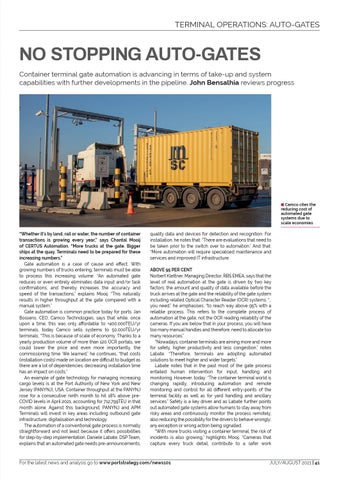TERMINAL OPERATIONS: AUTO-GATES
NO STOPPING AUTO-GATES Container terminal gate automation is advancing in terms of take-up and system capabilities with further developments in the pipeline. John Bensalhia reviews progress
8 Camco cites the reducing cost of automated gate systems due to scale economies
“Whether it’s by land, rail or water, the number of container transactions is growing every year,” says Chantal Mooij of CERTUS Automation. “More trucks at the gate. Bigger ships at the quay. Terminals need to be prepared for these increasing numbers.” Gate automation is a case of cause and effect. With growing numbers of trucks entering, terminals must be able to process this increasing volume. “An automated gate reduces or even entirely eliminates data input and/or task confirmations, and thereby increases the accuracy and speed of the transactions,” explains Mooij. “This naturally results in higher throughput at the gate compared with a manual system.” Gate automation is common practice today for ports. Jan Bossens, CEO, Camco Technologies, says that while, once upon a time, this was only affordable to +400,000TEU/yr terminals, today Camco sells systems to 50,000TEU/yr terminals. “This is because of scale of economy. Thanks to a yearly production volume of more than 120 OCR portals, we could lower the price and even more importantly, the commissioning time. We learned,” he continues, “that costs (installation costs) made on location are difficult to budget as there are a lot of dependencies, decreasing installation time has an impact on costs.” An example of gate technology for managing increasing cargo levels is at the Port Authority of New York and New Jersey (PANYNJ), USA. Container throughput at the PANYNJ rose for a consecutive ninth month to hit 18% above preCOVID levels in April 2021, accounting for 712,799TEU in that month alone. Against this background, PANYNJ and APM Terminals will invest in key areas including outbound gate infrastructure, digitalisation and technology. The automation of a conventional gate process is normally straightforward and not least because it offers possibilities for step-by-step implementation. Daniele Labate, DSP Team, explains that an automated gate needs pre-announcements,
quality data and devices for detection and recognition. For installation, he notes that: “There are evaluations that need to be taken prior to the switch over to automation.” And that: “More automation will require specialised maintenance and services and improved IT infrastructure. ABOVE 95 PER CENT Norbert Klettner, Managing Director, RBS EMEA, says that the level of real automation at the gate is driven by two key factors: the amount and quality of data available before the truck arrives at the gate and the reliability of the gate system including related Optical Character Reader (OCR) systems. “… you need,” he emphasises, “to reach way above 95% with a reliable process. This refers to the complete process of automation at the gate, not the OCR reading reliability of the cameras. If you are below that in your process, you will have too many manual handles and therefore, need to allocate too many resources.” “Nowadays, container terminals are aiming more and more for safety, higher productivity and less congestion,” notes Labate. “Therefore, terminals are adopting automated solutions to meet higher and wider targets.” Labate notes that in the past most of the gate process entailed human intervention for input, handling and monitoring. However, today: “The container terminal world is changing rapidly, introducing automation and remote monitoring and control for all different entry-points of the terminal facility as well as for yard handling and ancillary services.” Safety is a key driver and as Labate further points out automated gate systems allow humans to stay away from risky areas and continuously monitor the process remotely, also reducing the possibility for the drivers to behave wrongly; any exception or wrong action being signalled. “With more trucks visiting a container terminal, the risk of incidents is also growing,” highlights Mooij. “Cameras that capture every truck detail, contribute to a safer work
For the latest news and analysis go to www.portstrategy.com/news101
JULY/AUGUST 2021 | 41









